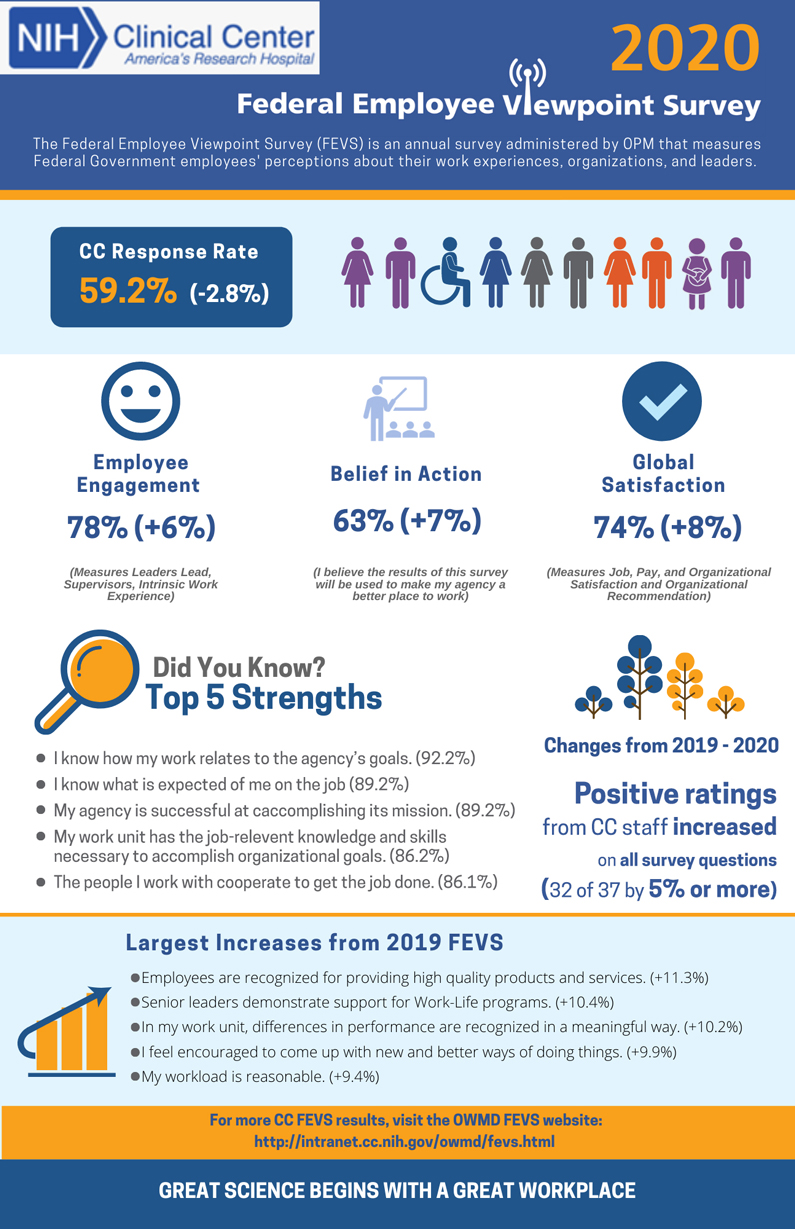Employee survey held during pandemic identifies positives and improvements for the Clinical Center
1,000 of your colleagues in the Clinical Center spoke out: what were the take-aways?

The Federal Employee Viewpoint Survey (FEVS) is an annual event but this year's survey was far from routine. It was administered during a pandemic, when much of the Clinical Center's workforce was teleworking.
The annual employee survey is administered by the Office of Personnel Management, and measures federal employees' perceptions about work experiences, organizations and leadership. The survey was open for six weeks in the Fall of 2020 and was emailed to all full and part-time permanent, non-seasonal employees, including Title 42 and Commissioned Corps staff, who came on-board on or before October 26, 2019.
Surveys were sent individually and responses were collected anonymously to ensure honest feedback. Clinical Center departments with sections have ten or more respondents receive data for their sections. Results were also assessed on global satisfaction and employee engagement scores.
The survey results provide valuable insight for Clinical Center leaders on how their staff feel they are managing challenges in the workplace.
Dr. Gilman emphasized in his April Town Hall meeting that he takes the FEVS results very seriously. He works closely with each of the hospital's Department Heads to ensure they are working on action plans to address their specific results. Gilman noted "The survey is an important tool that Clinical Center leaders examine closely and can have a major impact on how the hospital operates."
Due to the pandemic, the 2020 survey was customized, focusing less on traditional queries and adding some COVID-19 related questions. Even though staff participation in the survey was slightly lower than in 2019, many metrics improved. These included Employee Engagement, which measures the effectiveness of leaders and the intrinsic work experience; Belief in Action, which measures confidence that the results of the survey are used to improve the workplace; and Global Satisfaction, which measures pay, organizational satisfaction and recommendations.
Top Ratings
Positive ratings from CC staff increased from 2019 on all survey questions – 32 of 37 by 5% or more.
The department that had the highest increase in participation in the 2020 FEVS was the Critical Care Medicine Department – up 14%.
One highlight from the survey is that almost 90% of CC staff believe senior leaders demonstrated commitment to employee health and safety during the COVID-19 pandemic.
The Employee Engagement Index (EEI) is a key metric that can be compared year to year, and is drawn from a composite of responses to several questions which measure the intrinsic work experience. Overall, EEI increased by 6% at the Clinical Center. Of note, no CC group experienced an EEI drop.
Departments that showed double-digit increases in EEI were: Social Work; Materials Management and Environmental Services; Nursing - Nursing Operations; Nursing - Oncology and Critical Care; Office of the Chief Medical Officer; Office of Communications and Media Relations; and Positron Emission Tomography.
Top Three Positives & Opportunities for Improvement
This year's results captured people's satisfaction with their role on the organization and alignment with the Clinical Center and NIH's mission.
The highest percent positive responses:
- I know how my work relates to the agency's goals. (92.2% selected agree or strongly agree for this response)
- I know what is expected of me on the job. (89.2%)
- My agency is successful at accomplishing its mission. (89.2%)
Some items continue to have room for improvement. Pay and performance were two areas staff felt could be improved:
- In my work unit, steps are taken to deal with a poor performer who cannot or will not improve. (24.1% selected disagree or strongly disagree this response)
- Considering everything, how satisfied are you with your pay? (22.8%)
- In my work unit, differences in performance are recognized in a meaningful way. (18.4%)
Using FEVS Results
Kathy Baxley, chief of the Clinical Center Social Work Department, found the FEVS data incredibly valuable in improving the department's work environment. She says the survey provides metrics that show a department's weakness and strengths.
A couple years ago, Baxley decided to really focus on improving her team's indices. Staff held a retreat and based on feedback, made multiple changes in the way the department operated, on-boarded new staff and provided ongoing support for each other.
For the 2020 survey, the Social Work Department's Employee Engagement Index increased by 48 percent. Baxley noted that it is possible to have an engaged department, but it must be intentional. It takes support from the top and a willingness for the team to put in the effort to improve.
"It takes the whole team to make the work environment great," added Baxley.
The FEVS is an important way for leaders to receive feedback and for departments to improve. But everyone's participation is key. The FEVS survey for 2021 is tentatively planned for the fall of 2021.
View the full 2020 results for the Clinical Center (NIH only)
View more information on the FEVS at the Clinical Center and NIH (NIH only)
- Debbie Accame